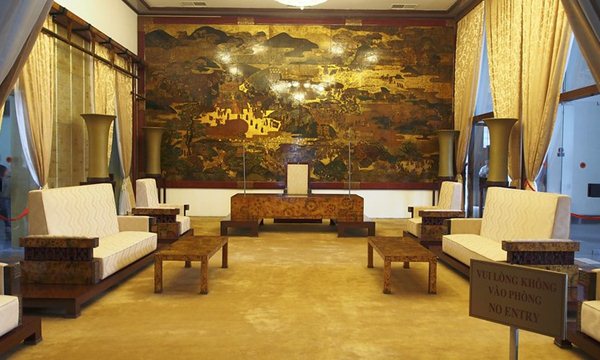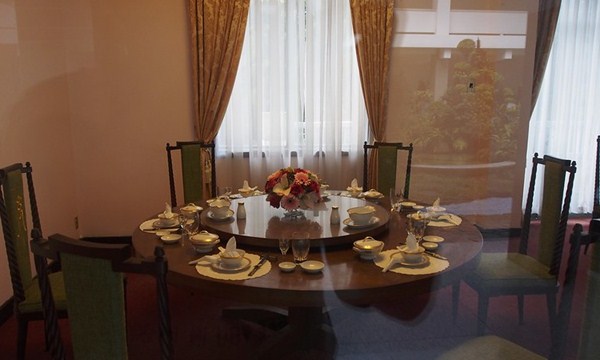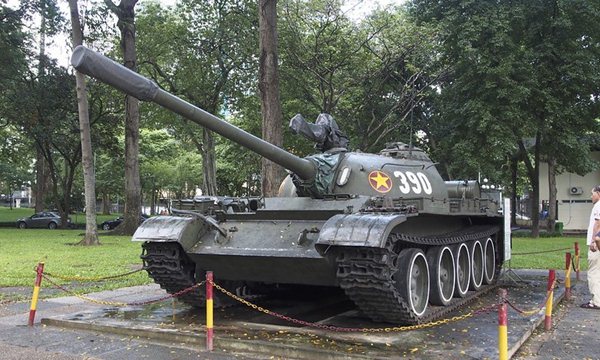Independence Palace, also called the Reunification Palace, has existed for over a hundred years in Saigon, witnessing many fluctuations of history. This place is a highlight point during the ending-war date of 30 April 1975, marking the reunification of Vietnam. Let’s visit this historical place to learn more about the wartime in Vietnam!

The Reunification Palace in Ho Chi Minh City
- Address: 135 Nam Ky Khoi Nghia Street, Ben Nghe Ward, District 1, Ho Chi Minh City, Vietnam. It is also near Notre Dame Cathedral, 30/4 park, and Saigon Post Office.
- Opening hours of Independence Palace: Morning from 8:00 am to 11:30 am, and afternoon from 13:00 to 17:00.
- Ticket sale hours: Morning from 8:00 am to 11:00 am; afternoon from 13:00 to 16:00.
- Price for ticket: Adults: VND 65,000 / person; Student: VND 45,000 / person; Children: VND 15,000 / person
- Phone number: 02838 223 652
- Website: https://dinhdoclap.gov.vn
The architectural beauty of Independence Palace
The Independence Palace is designed to represent the traditional philosophy in a harmonious combination with modern architecture. The whole surface of the building follows the shape of the word “Cat”, which means good luck.
Located in the central area of Ho Chi Minh City, the green trees cover the main house. Four streets are surrounding it, namely Nam Ky Khoi Nghia in the Northeast, Huyen Tran Princess Street in the Southwest, Nguyen Thi Minh Khai in the Northwest, and Nguyen Du in the Southeast. The Reunification Palace connects with the two green parks: the 30 April and Tao Dan Park.
The building was built following Vietnamese feng shui architecture, including the growing garden and the main palace. All combine smoothly between modernity and tradition.

In front of the palace are a sprinkler and the forest behind it, representing the skill of leaning on the mountain, and facing the water. This feature makes this site have solid development. In particular, on the campus of the palace, there are plenty of big trees with different species, creating fresh air for the people living and working inside.
Besides, the green oval grass in the courtyard of the palace contributes to the opening scenery and refreshing feeling when entering the garden. And, the water pond right in the yard is both making fresh air and protecting the palace to avoid the road running in front.
The architectural beauty of the palace also shows by the stone curtain in the shape of bamboos around the 2nd floor. It can be said that the Independence Palace is one of the most attractions in Ho Chi Minh City for tourists to explore history and architecture.
When visiting the palace, you see almost intact furniture at the residence and work of a head of state. You will be surprised by the large size of lacquer and oil paintings that occupy an entire wall. Dozens of precious artworks, thousands of lamps, old tables and chairs, and high-quality items have stored and displayed here. Especially in the centre room of the 2nd floor, furniture and decorative paintings are made of traditional lacquer material.
The Independence Palace is a beautiful building in Saigon. The mansion is designed to send the wish for the prosperity and lasting sustainability of the nation.
The building has a height of 26m, equivalent to an eight-story building, flanked by a 12-hectare garden. The palace is built with 3 main floors, a terrace where the helicopter to land, and 2 underground floors. Now, in the Independence Palace, there are three main displaying areas, including a fixed area, thematic room, and supplementary place.

Fixed area:
This construction includes some main rooms as below.
- Chamber: Room with a capacity of over 500 people, used to be the venue for meetings, receptions, cabinet launch ceremonies. The room is still used for important meetings in Vietnam.
- Cabinet Room: A meeting place for the Council of Presidents and the Cabinet of South Vietnam.
- Library in Independence Palace: is on the 3rd floor of the mansion, including many bookcases, large windows for light, and a reading table in the middle of the room. It contains a lot of books and research papers of the old presidents.
- Strategic Operations Department: This is a military information gathering room from other regions. Through the operational map system, the staff will update, monitor, and deploy military plans.
- Underground floor: The basement is full of communication rooms, printing rooms… to ensure the release of the President’s orders to the outside.
- Presidential Family Residence: the Presidential Family Residence has the longest living time is Mr Nguyen Van Thieu (from October 1967 to 21 April 1975).
When visiting this place, you will see the vivid relics preserved until now, and understand somewhat a period of the heroic and fierce war of the nation.
Thematic area:
It is a display area for topics such as “Ho Chi Minh Road through documents of the Saigon government”, “From Paris Agreement to Ho Chi Minh campaign through old documents” or photo exhibitions such as ” Vietnam – Song of victory “.
You can see the impressive images of the previous period, and also know more about the hidden historical details that are not written by any newspapers. Those are the value collections, the hard work of historical experts, which contribute to the museum.
Typically, you do not miss the opportunity to visit the exhibition area entitled “From Norodom Palace to Independence Palace 1868 – 1966”. This gallery simulates the process of formation, construction, historical landmarks, and important events happening at Independence Palace.
Visiting this exhibit area, we will see the past historical memories in a new way. We partly understand the cruelty of war, which can help us have a better life in the present.

Additional area:
This room is a gallery of images to be found and collected later. The photos from the public came to the palace to preserve and transmit for future generations.
Looking at these historical photos gives tourists a sense of slowing down as if returning to a historical moment in the past.
In this place, the elder generations have the opportunity to look back on their heroic times, and the young people could feel the glorious resistance and joy of victory that many people sacrificed for independence. Since then, we have more respect and love than history to live better.
Highlight artifacts preserved at the Independence Palace
Visiting the Reunification Palace, you can see the dreadful wars through historical artifacts preserved well.
On the roof of the building, there is a UH-1 helicopter of President Nguyen Van Thieu, next to the location of two bombs that pilot Nguyen Thanh Trung threw down.
The Mercedes Benz 200 W110 with number plate VN-13-78 of Germany is one of the cars that President Nguyen Van Thieu used to move.
The Jeep M152A2 was driven by the Revolutionary force to transport Mr Duong Van Minh – the last President of the South Republic of Vietnam to Saigo radio to read his declaration of surrender at noon on 30 April 1975.
Besides, tank 390, tank 843, and F5E combat aircraft have also contributed to making the Reunification Palace more attractive for tourists.

Visiting Independence Palace, you can also admire many valuable works of art. One of them is an oil painting depicting the countryside of Vietnam, which was painted by architect Ngo Viet Thu in 1966. The painting “Binh Ngo Dai Cao” consists of 40 pieces assembled depicting the life peaceful life of Vietnamese people in the 15th century.
Besides visiting the main area, you can take a stroll in the green garden to look at the palace at different corners.
The Reunification Palace is a symbol of Saigon and the pride of the Vietnamese people. Exploring this historic site will be a memorable experience. In particular, if you are a historical believer, this is a treasure of evidence for you to study.
>>> You may like to see a nearby attraction: War Remnants Museum.
The notes when visiting the Reunification Palace
The Independence Palace is a vital historical place in Vietnam. When going to this site, you need to follow the rules of the management board of the monument.
- Formal clothes,
- Follow the instructions of the guard and signs during the visit,
- Do not bring luggage inside the monument,
- Do not bring food and drink into the monument,
- Do not carry animals into monuments,
- Do not bring weapons, explosives, toxic chemicals,
- Visitors will be responsible if causing any loss to the relics here.